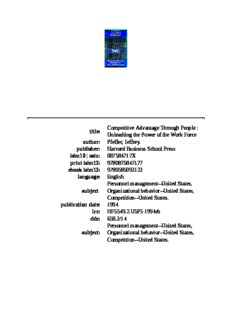
Competitive advantage through people: unleashing the power of the work force PDF
Preview Competitive advantage through people: unleashing the power of the work force
Competitive Advantage Through People : title: Unleashing the Power of the Work Force author: Pfeffer, Jeffrey. publisher: Harvard Business School Press isbn10 | asin: 087584717X print isbn13: 9780875847177 ebook isbn13: 9780585093123 language: English Personnel management--United States, subject Organizational behavior--United States, Competition--United States. publication date: 1994 lcc: HF5549.2.U5P5 1994eb ddc: 658.3/14 Personnel management--United States, subject: Organizational behavior--United States, Competition--United States. Competitive Advantage Through People Unleashing the Power of the Work Force Jefferey Pfeffer Stanford University Graduate School of Business HARVARD BUSINESS SCHOOL PRESS Boston, Massachusetts First published in the United States by the Harvard Business School Press in hard cover, 1994; in paperback, 1995 Copyright © 1994 by Jeffrey Pfeffer All rights reserved Printed in the United States of America 99 98 543 (pbk.) LIBRARY OF CONGRESS CATALOGING-IN-PUBLICATION DATA Pfeffer, Jeffrey. Competitive advantage through people: unleashing the power of the work force / Jeffrey Pfeffer. p. cm. Includes bibliographical references and index. ISBN 0-87584-413-8 (hc) ISBN 0-87584-717-X (pbk) 1. Personnel managementUnited States. 2. Organizational behaviorUnited States. 3. CompetitionUnited States. 1. Title. HF5549.2.U5P5 1994 658.3'14dc20 93-26599 CIP The paper used in this publication meets the requirements of the American National Standard for Permanence of Paper for Printed Library Materials Z39.49-1984. CONTENTS Acknowledgments vii Part I Performance through People 1. Sources of Sustained Success 3 2. What Effective Firms Do with People 27 3. The Evidence for Slow Learning and Unrealized 67 Potential Part II Barriers to Doing the Right Thing 4. Wrong Heroes, Wrong Theories, Wrong Language 93 5. Overcoming History 117 Page vi 6. Labor Laws, Lawyers, and Litigation: Friends or Foes 137 of Work Place Change? 7. Employee Organizations: Their Effects and Role in 159 Work Place Reform 8. Resistance from Within 183 Part III Prospects for Change 9. The Promise of the Quality Movement 205 10. Making the Change 223 Notes 255 Index 273 Page vii ACKNOWLEDGMENTS This book has only one author, but many people have provided tremendous encouragement and assistance in its development. When Jim Baron joined the Stanford faculty in 1982, in addition to teaching our core course in organizational behavior, he wanted to develop an elective. "Why not do something that incorporates your research in organizations and labor markets?" I said. The elective he first taught, which I subsequently taught and which he now teaches again, will soon be part of our core curriculum. The absence of a good text for the course prompted me to write this book. Over the years, he and I have spent numerous hours talking about issues in the management of a firm's human resources. Not only has he been a great colleague, but he took a first draft of this manuscript on a trip to Singapore and provided detailed comments on his return. He, and the students I have taught in the course, have helped me clarify my thinking enormously. A number of friends provided useful commentary on early drafts of the manuscript. Beth Benjamin once again took time away from her Page viii doctoral dissertation and Stan Winvick stole time from his busy schedule at Advanced Micro Devices to provide very important guidance. Much of what I know about achieving competitive advantage through the work force I have learned from some truly remarkable individuals in interesting firms. Dave Spence and Jay Duhon of Boise Cascade, Vit Eckersdorf of Bofors, and Peter Thigpen of Levi Strauss were kind enough to share their wisdom and experience with both me and my students. Robert Mountain, Bill Izabal, and numerous managers gave freely of their time to describe the process of changing human resource practices at ESL. Stan Winvick and his colleagues at AMD arranged opportunities to learn about what that firm was doing, how, and why. Special thanks go to two people. Rick Seaman, a student of mine at Stanford is now with the Solectron Corporation. He, Wait Wilson, manager of the Milpitas site, Ko Nishimura, the CEO, and many other Solectron employees provided important information and perspective. Rick read a first draft of the manuscript. Working in a Baldrige- award-winning company, he was used to measures. So he gave me a chart showing the proportion of each of those chapters he had highlighted. I hope I did better with this version. And Charles O'Reilly, who moved from Berkeley to Stanford as the book was being written, read the manuscript twice, providing examples, insights, and most of all, encouragement and enthusiasm. As I revised the manuscript, Rick's and Charles' questions and comments were foremost in my mind. This is my sixth book and the second with the Harvard Business School Press. My friends at the Press, particularly Carol Franco, my editor, and Natalie Greenberg, an editor who can both devastate your work and help it at the same time, as well as the people who market the books, have earned my undying gratitude. They all exemplify the idea of quality people and a quality organization. I appreciate all their efforts on my behalf. The Stanford Graduate School of Business supports me generously. I particularly appreciate our dean, Mike Spence, and my colleagues in organizational behavior who almost always understand that my primary job is research and teaching and give me the time and freedom to do Page ix itand don't complain about my missing meetings, when I do, too loudly. This book would never have been finished on time, or perhaps at all, without the gracious, friendly, and extraordinarily competent help of my assistant, Joni Podolsky. Joni provided comments, questions, and editing. Working with her on this project has been a pleasure. This book is dedicated to the amazing Kathleen, the keeper of my spirit, my best friend, and a person of beauty, grace, and above all, courage and determination. Page 1 I PERFORMANCE THROUGH PEOPLE
Description: